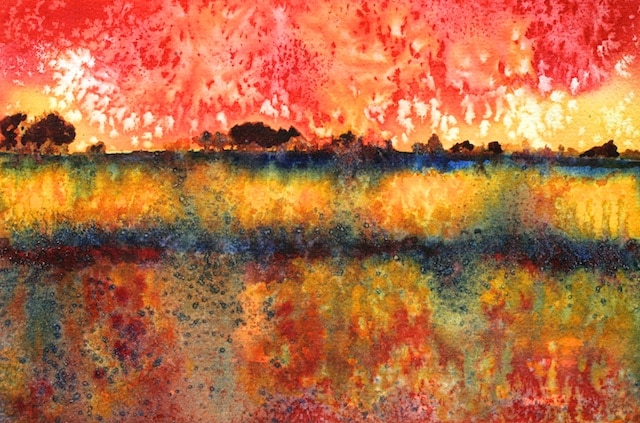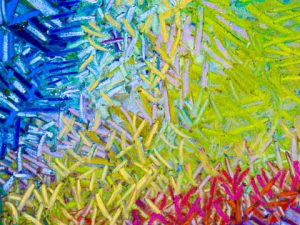
Enchanted Glen (oil) by Polly Castor
It is thought that a cohesive painting style is important in order to have a clear artistic voice and to carve out your niche. Think of spatter paintings, and you think of Jackson Pollack. Think of big flowers or scull bones and you think of Georgia O’Keefe. Because we want our work to be recognizable, artists are often encouraged to find their “thing” and just do that.
One pastel artist I know just does figures underwater blowing bubbles. I loved her work when I first saw it, with all it’s refracted light on the surface with their aqueous swirls, until I saw the next ones, and they were endlessly more of the same. At an art fair once, we saw an art seller offering Van Gogh-esque paintings for high prices. He had distilled down the short reverberating type of stroke Van Gogh used, and reproduced it on some classically timeless landscapes. They were appealing in one way, but felt gimmicky and commercial; there was none of this own artist’s voice there; they were fakes.
So I am often asked what makes up style, especially since mine is seemingly all over the place. However, even though I use different subject matter, different media, different techniques, and different processes, when you walk into a one woman show of mine, you can tell they are all mine. I seem to have a resounding voice, even though I explore multiple, cross-pollinated paths. I would argue for authenticity as the most unifying factor for an artist. That’s the quality that actually put Van Gogh, Georgia O’Keefe, and Jackson Pollack on our radar to begin with.
Let’s look at the things that combine together to create what feels like an artist’s style. It is a combination of subject matter, mark making, medium, palette, and technique. Even though these things overlap with one another, we’ll initially look at them separately below, one at a time.
Let’s consider the variable of medium first. Someone’s style can look very different depending on what medium they are using. Watercolor, colored pencils, and oil pastels will create very different looks painting the same subject matter. Other mediums can more easily resemble each other on the page, even though their method of application is entirely different. Often artists settle on using only one medium, which allows them to pursue expertise and keep costs down. However, the main impetus is to narrow in on a signature “style,” and using only one medium is a fast track to that goal.
Mark making and technique can be very recognizable. Mark making was the hallmark of both Jackson Pollack and Van Gogh. My hand is drawn to broken line, sinuous shapes, dottiness, and layering. Most of my edges are hard, not because I can’t make soft ones, but because I like definitiveness and crisp clarity, even though someone who professes the use of soft edges might say mine “scream.” (Yes, I’ve been told that.) Maybe I’m just intense? But in the same way, I may feel their soft edges are feeble and not compelling. But the important question is whether that is authentic to them? Additionally, each medium has very different techniques of application. Layering in pastels is a very different practice than in acrylics. Texture and transparency are achieved in completely different ways, with different results.
Subject matter is another thing that unifies style. Some people only do portraits, others focus on still-lifes, or urban scenes at night, or aerial views, or florals, while others do landscapes. In the landscape category, there are people that only do seascapes, marsh scenes, mountains, or fields. Some paint “en plein air” (i.e. from life), or paint from photographs, or paint from their imagination or memory. Each one of those approaches will yield quite different results, even for the same subject matter. Then there are us abstract folks, with again a menu of different types, reasons, and thinking behind them.
The last thing to consider is palette. Mine is fairly bright and vivid. Color is exciting to me, and I can’t get too much of it. Other people love neutrals. I only use neutrals as needed to boost my colors. Other people only use colors as needed to boost their neutrals. A fellow blog reader of yours (and pastel friend of mine) uses turquoise, teal, periwinkle, and royal blue, together with kelly and spring green in almost every painting. I love those colors too, and between that palette, her confident mark making, and consistently using the medium of pastel, her style is straight forward, sharp and pleasing– all her own.
For those who have what most people call a clear “style,” they usually have narrowed each of those categories above. Erin Hanson only paints landscapes in oil, only from photographs taken when the sun was low and the shadows pronounced, while using a stained glass window technique for filling in her image with jewel toned colors. The results are fairly uniform, even though the landscape configurations are not the same. A pastellist friend of mine paints meticulous rocks in tide pools with bubbles that are instantly recognizable if you’ve seen one of hers before. So again, the same medium, the same mark making, the same palette, and the same subject matter, will automatically read as a consistent style.
If that floats their boat, then great. I know in the pottery studio, when I first did sgraffito, it was so meditatively happiness inducing that ever since, that’s all I really want to explore when working in clay. And because of that, my style in clay seems predictable. Within that narrow technique there is more than enough for me to play with, but there is not much of a wide range between the pieces when looking at them.
But for me, in a larger context, the excitement and the discovery process of being an artist makes me unwilling to settle on a widget that I can make (that sells) and then to hit production mode, repeatedly reproducing it. I want to explore ideas in whatever way will best express them. Those ideas will determine the medium, the marks, the palette, the techniques. So I work in a broad spectrum, through the whole range of abstraction, including impressionism, plein air, story telling, conceptualism, and expressionism. I use a whole menagerie of mediums too: pastel, oil, acrylic, collage, mono-printing, oil pastels, colored pencils, watercolor, ink, gouache, and mixed media. What best conveys what I’m trying to say?
The default marks my hand likes to make, the scope of techniques I bring to bear in each media I utilize, and my strong, saturated palette, begin to define my “style,” while the huge thought process of meaning, metaphor, and spiritual connection behind everything is really at the heart of it, and is actually what unifies all my work.
So if you are an artist, and want to slide into a recognizable style, limit yourself to one medium, one palette, one type of mark making, and a repeated subject matter. It is a formula that works, but it may not bring out your best ardor and most joyous zeal. I’m here to say, however, that you can easily find your style outside that formula.
I just heard on a podcast last week that the worse thing for an artist is for them to be bored, because if they are bored, then their audience will be bored too. I agree with that. The formulaic approach discussed above seems like a straight jacket to me. It seems like a prescription for boredom too, or worse, losing interest in painting.
I think art making is a time to be free to express myself, to put away the cares of the world, and listen inwardly. Allowing myself as many variables as possible unleashes that freedom to be freshly creative, letting ideas take flight and soar. It is a time to allow ideas to percolate, to try things that may or may not work, to be curious, to combine unusual components for something original and new. I think making art should be a time for whoever you are in that moment to be released into the world, and not be about some former version of yourself that got prescribed into a template.
I feel the world needs you as an artist at your most genuine, passionate, unfiltered, vulnerable, raw and true. It needs your authenticity, for there will never be another you. There is enough posturing and contrivance in this world already. And the fact remains that the more you paint this way, and even if it seems all over the lot, the unifying factor still is present. If it is really “you,” than there will be that inherent unifying style.
People tell me they can quickly spot “a Polly Castor,” and that this is true regardless of whether it is a landscape or a conceptualist piece. The same can be said for any artist, in proportion to their being steadfastly true to their inmost authentic self. You don’t do yourself or the world a favor by limiting either yourself, or the variables you utilize to express yourself. I can’t recommend highly enough being deeply authentic in every area of life, but it is especially a boon in the painting process. Step out in the confidence of your own unique style!

Chambers of the Heart (acrylic) by Polly Castor

To the Tree, To the Tree (pastel) by Polly Castor

Seize the Day (pastel) by Polly Castor

91st Psalm (oil) by Polly Castor

Moonlight on the Seaside Cliffs (watercolor) by Polly Castor

What it Takes to Sing (acrylic) by Polly Castor

Dreamtime (Gouache) by Polly Castor

Prairie Thunderstorm (watercolor) by Polly Castor

Serendipity (oil) by Polly Castor
3 Comments
-
I am drawn more to your oils, watercolors, and acrylics….I find them giving and assurance of “security and love” . They provide a cloister of hope.
❤️ -
I couldn’t agree more about using different mediums and approaches to our work. Here in Australia my work hasn’t been picked up in galleries for one reason…it is too varied!!!! They say, if it takes off then their clients want to know what to expect when I put on a new exhibition! I thought that was an appalling thing to say! I don’t WANT the people to know what to expect because that means the work is predictable and will soon be uninteresting to everyone, including me.
-
Author
Like I said. Soul sisters. I totally understand.
-






